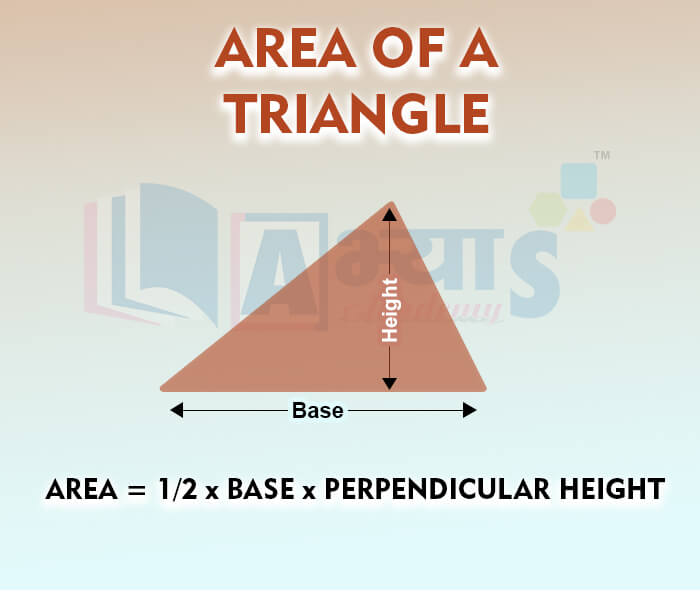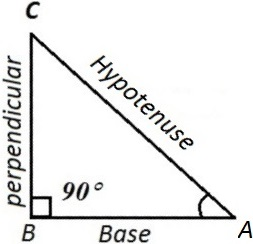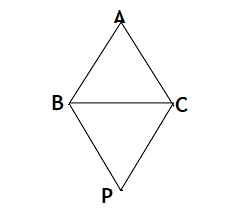Area of Triangle





Area of Triangle
Area of Triangle: Area of a triangle is equal to half of the product of base and height
A right triangle is the one in which the measure of any one of the interior angles is 90 degrees. It is to be noted here that since the sum of interior angles in a triangle is 180 degrees, only 1 of the 3 angles can be a right angle. If the other two angles are equal, that is 45 degrees each, the triangle is called an isosceles right angled triangle. However, if the other two angles are unequal, it is a scalene right angled triangle. Area of Triangle = Perimeter of a right triangle = a + b + c = Sum of three sides Where a, b and c are the measure of its three sides. Pythagoras Theorem defines the relationship between the three sides of a right angled triangle. Thus, if the measure of two of the three sides of a right triangle is given, we can use the Pythagoras Theorem to find out the third side. Example: Find The Area Of A Right Triangle as given: AB = 4cm and AC = 3cm Solution: using Pythagoras theorem, BC = 3 cm Area of triangle= |  |
Theorem 1 The area of a triangle is half the product of any its sides and the corresponding altitude.
Given A To prove Construction Through Proof By construction we have, BA || CD and AD || BC Since
Beacuse is the base and Hence Proved. |  |
Given A in which AL is the altitude to the side BC.
To prove
Construction Through and
draw
and
respectively, intersecting each other at
Proof We have,
[ By construction]
and, [ By construction]
is a parallelogram.
Since is a diagonal of
[
is the base and
is the corresponding
altitude of ]
[ Fig. required (pg. no. 15.7) xxxxx]
In
| |||
| Right Option : B | |||
| View Explanation | |||
In the given figure, if ar(PBC) = 20 sq units, then ar(ABPC) = ________________
| |||
| Right Option : B | |||
| View Explanation | |||
A ____________ of a triangle divides it into two triangle of equal area . | |||
| Right Option : B | |||
| View Explanation | |||
Students / Parents Reviews [20]
Abhyas academy is great place to learn. I have learnt a lot here they have finished my fear of not answering.It has created a habit of self studying in me.The teachers here are very supportive and helpful. Earlier my maths and science was good but now it has been much better than before.

Barkha Arora
10thAbhyas is good institution and a innovative institute also. It is a good platform of beginners.Due to Abhyas,he has got knoweledge about reasoning and confidence.My son has improved his vocabulary because of Abhyas.Teacher have very friendly atmosphere also.

Manish Kumar
10thAbout Abhyas metholodology the teachers are very nice and hardworking toward students.The Centre Head Mrs Anu Sethi is also a brilliant teacher.Abhyas has taught me how to overcome problems and has always taken my doubts and suppoeted me.

Shreya Shrivastava
8thIt has a great methodology. Students here can get analysis to their test quickly.We can learn easily through PPTs and the testing methods are good. We know that where we have to practice

Barkha Arora
10thBeing a parent, I saw my daughter improvement in her studies by seeing a good result in all day to day compititive exam TMO, NSO, IEO etc and as well as studies. I have got a fruitful result from my daughter.

Prisha Gupta
8thAbhyas is a complete education Institute. Here extreme care is taken by teacher with the help of regular exam. Extra classes also conducted by the institute, if the student is weak.

Om Umang
10thMy experience was very good with Abhyas academy. I am studying here from 6th class and I am satisfied by its results in my life. I improved a lot here ahead of school syllabus.

Ayan Ghosh
8thI have spent a wonderful time in Abhyas academy. It has made my reasoning more apt, English more stronger and Maths an interesting subject for me. It has given me a habbit of self studying

Yatharthi Sharma
10thIn terms of methodology I want to say that institute provides expert guidence and results oriented monitering supplements by requsite study material along with regular tests which help the students to improve their education skills.The techniques of providing education helps the students to asses...

Aman Kumar Shrivastava
10thIt was a good experience with Abhyas Academy. I even faced problems in starting but slowly and steadily overcomed. Especially reasoning classes helped me a lot.

Cheshta
10thAbhyas institute is one of the best coaching institute in the vicinity of Ambala Cantt area. The teachers of the institute are well experienced and very helpful in solving the problems of the students.The good thing of the institute is that it is providing extra classes for the students who are w...

Aman Kumar Shrivastava
10thAbhyas institute is one of the best coaching institute in the vicinity of Ambala cantt.The institute provides good and quality education to the students.The teachers are well experienced and are very helpful in solving the problems. The major advantages of the institute is extra classes for weak...

Shreya Shrivastava
8thWhen I have not joined Abhyas Academy, my skills of solving maths problems were not clear. But, after joining it, my skills have been developed and my concepts of science and SST are very well. I also came to know about other subjects such as vedic maths and reasoning.

Sharandeep Singh
7thMy experience with Abhyas is very good. I have learnt many things here like vedic maths and reasoning also. Teachers here first take our doubts and then there are assignments to verify our weak points.

Shivam Rana
7thUsually we see institutes offering objective based learning which usually causes a lag behind in subjective examinations which is the pattern followed by schools. I think it is really a work of planning to make us students grab the advantages of modes of examination, Objective Subjective and Onli...

Anika Saxena
8thAbhyas is an institute of high repute. Yogansh has taken admission last year. It creates abilities in child to prepare for competitive exams. Students are motivated by living prizes on basis of performance in Abhyas exams. He is satisfied with institute.

Yogansh Nyasi
7thIt was good as the experience because as we had come here we had been improved in a such envirnment created here.Extra is taught which is beneficial for future.

Eshan Arora
8thOne of the best institutes to develope a child interest in studies.Provides SST and English knowledge also unlike other institutes. Teachers are co operative and friendly online tests andPPT develope practical knowledge also.

Aman Kumar Shrivastava
10thMy experience with Abhyas Academy has been very good. When I was not in Abhyas whenever teacher ask questions I could not speak it confidently but when I came in Abhyas, my speaking skills developed and now I am the first one to give the answer of teachers question.

Upmanyu Sharma
7thMy experience with Abhyas academy is very good. I did not think that my every subject coming here will be so strong. The main thing is that the online tests had made me learn here more things.

